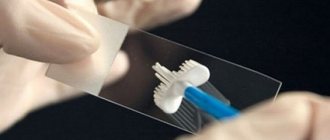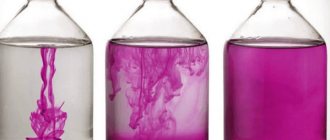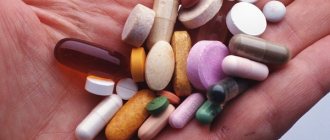Toxic hepatitis is a liver disease, acute or chronic, developing as a result of the ingestion of chemicals or other harmful substances into the body, their toxic effect on liver cells, accompanied by inflammation of the cells and their death, and manifested by an increase in the liver in size, pain in the right hypochondrium and progressive jaundice.
Acute toxic hepatitis, called “Acute toxic hepatitis,” develops as a result of exposure to a single, large concentration of poison or a small dose of poison that has an affinity for liver cells; as a rule, symptoms appear after 2-5 days.
Toxic hepatitis of a chronic course, called “Chronic toxic hepatitis”, develops with repeated exposure to poison, in small doses, which does not have an affinity for liver cells, and can manifest itself after months or years. Manifestations of acute toxic hepatitis, expressed, are severe, the patient must be urgently hospitalized, and if medical care is not provided in a timely manner, it can lead to death. Chronic toxic hepatitis develops slowly, symptoms appear gradually, and if the cause is not eliminated, they are complicated by liver cirrhosis and liver failure.
Classification and causes
There are several types of toxic hepatitis according to the type of substance involved. These include:
- Alcoholic. The liver is pathologically affected by alcohol abuse, due to which pathological processes begin to develop.
- Medication. It is caused by taking medications unnecessarily and in large quantities. Over time, the body may become poisoned by their active components.
- Food. In this case, toxic substances enter the body with food. Most often this happens due to poisonous mushrooms eaten.
Based on what substances can provoke this disease, we can identify the main risk groups. This:
- people employed in hazardous work;
- persons prone to alcohol abuse;
- patients who prefer not to wait for doctor’s orders to take medications, but begin treatment on their own and without taking into account instructions.
This disease can manifest itself in acute or chronic form:
- The acute form occurs when a large amount of toxic substances of any origin enters the body at once. The result is hepatitis with pronounced intensity of symptoms, developing over several days (2-5).
- The development of the chronic type of this disease is due to systematic minor effects on the body. In this case, the pathology develops gradually, without even showing symptoms at first. This can drag on for months and even years.
The development of toxic hepatitis begins with the penetration of chemicals into the body. Their harmful effects interfere with the normal functioning of organs and systems and lead to numerous disorders.
Particularly severe damage is caused to the liver, since it is involved in cleansing the body and removing pathological substances. If there are too many of them, the organ cannot cope with them, and its cells gradually begin to break down.
Subsequently, the liver increases in size, the patient experiences severe pain and other negative changes. If left untreated, this leads to organ destruction and death of the patient. But even timely measures do not guarantee a favorable outcome.
Note! The penetration of harmful substances into the body can be accidental or intentional. There are also some types of employment in which a person is forced to come into contact with poisons.
These substances can enter the body through the respiratory tract, through the skin or gastrointestinal tract. From there they penetrate the blood, after which they reach the liver. Toxic hepatitis does not occur with every chemical exposure to the body. Very often, the liver and other organs involved in cleansing, as well as the immune system, cope with the pathological influence. But under strong influence, resistance may be useless.
The same thing happens with long-term dangerous effects on the body. Gradually, the immune system weakens and organs wear out, resulting in hepatitis.
Toxic liver hepatitis: what is it and how to treat it?
The liver is one of the few organs in our body that is capable of regeneration. It carries out about 400 functions: barrier, metabolic, secretory, storage and many others. Hepatocytes, liver cells, performing the daily work of removing poisons and toxins from the body, are subject to enormous stress. Therefore, if harmful or toxic substances are supplied in large quantities, the liver may not be able to cope with its mission.
Under the influence of toxins, hepatocytes begin to die, which causes inflammation in the liver. An inflammatory process of a non-infectious nature is called non-viral or non-infectious hepatitis. If it was caused by exposure to any toxic product: medication, alcohol or poison, then hepatitis is called toxic.
What is toxic hepatitis?
Toxic hepatitis is an inflammatory disease of the liver, the source of which is the ingestion of toxic substances into the body that destroy this organ. The pathology causes inflammation of the liver tissues with their further death.
Toxic hepatitis tends to develop cirrhosis. The most vulnerable group of the population are those suffering from alcohol addiction and working with harmful substances.
- Persistent hepatitis;
- Parenteral hepatitis;
- Drug-induced hepatitis;
- Non-viral or non-infectious hepatitis.
Classification
Our readers successfully use Leviron Duo to treat the liver. Seeing how popular this product is, we decided to bring it to your attention. Read more here...
Toxic liver hepatitis has two forms: acute and chronic. The cause of acute hepatitis is a single exposure to a large amount of a toxic substance. The first symptoms of poisoning can be detected 2-5 days after the poison enters the body.
Chronic hepatitis develops against the background of systematic exposure to small doses of toxic substances on the body. The pathological process is characterized by slow development; symptoms of toxic hepatitis may appear after several years.
Depending on the toxic substance that caused the damage, they are divided into:
- Alcoholic hepatitis. It occurs in people suffering from alcohol addiction. Systematic consumption of alcoholic beverages and alcohol surrogates leads to the formation of acetaldehyde, a toxic substance that causes massive death of liver cells. Even daily consumption of a safe dose of alcohol (20-40 grams of alcohol for men, about 20 for women) can cause alcoholic degeneration of the liver tissue into fatty tissue.
- Drug-induced hepatitis. Medicines can provide more than just benefits. Some of them have a pronounced hepatotropic effect. If consumed in large quantities, acute toxic hepatitis can develop. Uncontrolled use of anticonvulsants, antipyretics, antituberculosis drugs, sulfonamides, etc. poses a serious danger.
- Occupational hepatitis. Working in hazardous industries, every day a person involuntarily exposes his body to severe stress. Industrial poisons, harmful emissions of toxic substances, heavy metals enter the body through the skin and respiratory tract. Systematic exposure to harmful substances has a destructive effect on the liver.
The so-called plant poisons, which are contained in poisonous mushrooms and plants, also pose a danger to humans.
Clinical picture of toxic hepatitis
Toxic hepatitis with an acute course is characterized by vivid symptoms that appear on days 2-4, less often every other day. With severe poisoning, the signs of toxic hepatitis are more pronounced. The following symptoms indicate the presence of liver disorders:
- Temperature increase,
- Enlarged liver and spleen,
- Dyspeptic syndrome,
- Asthenoneurotic syndrome,
- Progressive jaundice
- Nosebleeds.
With chronic toxic hepatitis, the symptoms are mild and may appear and disappear. When the process worsens, the patient is bothered by a dull pain in the right side, increased fatigue, weakness, gastrointestinal disorders, and itchy skin.
The first point of antitoxic therapy is to remove the factor that caused the disease: eliminating the toxic substance, prohibiting the consumption of alcoholic beverages, eliminating the toxic agent. Removal of the toxin from the body is carried out using droppers, gastric lavage, and taking antitodes. The patient must remain in bed.
To treat toxic hepatitis, choleretic agents, hepatoprotectors, and vitamin complexes are used. The patient must follow a mandatory diet; smoking and drinking alcoholic beverages are strictly prohibited. With timely treatment, the prognosis for toxic hepatitis is favorable.
Be the first to comment!
Risk factors for development
The likelihood of toxic damage to the gland increases in the following cases:
- Violation of the rules for taking medications (for example, analgesics). The risk group includes patients who take several medications at once or independently exceed the dosage.
- Concomitant diseases of the gland. Toxic liver hepatitis can develop against the background of cirrhosis or hepatosis. Then hepatocytes become vulnerable to the influence of harmful compounds.
- Already existing hepatitis. If a person has been diagnosed with hepatitis B or C, then the likelihood of damage to the gland by harmful substances and the development of HT increases.
- Age-related changes in the body. As you age, it becomes harder for the liver to break down toxins, so they stay in the body longer.
- Alcohol abuse. It is known that alcohol is a toxic substance that enhances the harmful effects of medications and also independently damages hepatocytes.
According to medical statistics, women are more likely to suffer from TG than men. This is due to the fact that their metabolic processes are slower.
In addition, the development of toxic hepatitis is influenced by certain hereditary diseases. Due to a genetic defect, the production of enzymes that are responsible for the breakdown of toxic compounds is disrupted, and as a result, the risk of developing TG increases.
TG is often diagnosed in patients who work in industrial plants and are in daily contact with toxins.
Stages
| Latent period | It begins with the entry of toxic substances into the body and continues until symptoms appear. |
| Stage of acute clinical manifestations | The following signs of toxic liver damage appear: jaundice, fever, weight loss, weakness and loss of appetite, dyspeptic disorders. At this stage, damage to vital organs is typical. |
| Exit stage | This is the interval from the most developed clinical picture to recovery or death. |
Prevention
To prevent the development of liver damage, it is necessary to adhere to a certain number of measures both at work and at home:
- mandatory compliance with safety regulations at industrial enterprises with hazardous working conditions;
- take medications only as prescribed by a doctor in a certain dosage and duration of therapy, avoiding self-medication;
- exclusion from drinking alcoholic beverages, especially of dubious quality;
- according to indications - taking hepatoprotectors;
- desire for proper and balanced nutrition;
- undergoing regular preventive examinations.
Compliance with the rules of prevention and careful attention to your health will prevent the entry of toxic substances into the body, prevent complications and severe liver damage.
Symptoms of toxic hepatitis
If we are talking about a chronic pathology, then it can be asymptomatic for a long time. Therefore, when signs of the disease appear, it already affects a large number of liver cells, which is fraught with serious conditions. In the acute form, signs usually appear quickly, so diagnosing the pathology in this case is much easier.
All toxic hepatitis is characterized by the presence of two groups of symptoms:
- signs of damage directly to the liver (jaundice, hepatomegaly, pain in the right hypochondrium);
- signs of toxic effects on other organs (depending on the chemical structure of the toxic substance).
Signs of acute toxic liver hepatitis
The main symptoms of acute toxic hepatitis are:
- The process begins abruptly, a maximum of 3-5 days after poisoning;
- Pain in the area of the right hypochondrium, of pronounced intensity, is associated with an increase in the size of the liver and its capsule;
- Body temperature reaches 38 degrees and above;
- Severe general weakness;
- Aches all over the body;
- Vomiting, possibly with blood;
- Nausea;
- Bleeding from the nose;
- Pinpoint hemorrhages under the skin;
- Spider veins;
- Disorientation in space;
- Lethargy or, conversely, mental and nervous activity;
- Darkening of urine;
- Lightening of stool;
- Jaundice;
- Enlarged liver.
Signs of chronic toxic hepatitis:
- Periodic pain in the right hypochondrium, of moderate intensity, worsening after eating;
- Heaviness in the right hypochondrium is associated with liver enlargement;
- Low-grade body temperature 37-37.5 C;
- Nausea, vomiting, loss of appetite, bitterness in the mouth, bloating, diarrhea, these manifestations develop as a result of a violation of the outflow of bile;
- Fatigue, decreased performance;
- Itchy skin, itchy skin due to the accumulation of bile acids;
- Enlarged liver and spleen.
These symptoms may subside for a while (remission) and appear again (worsen).
In most cases, the manifestations of toxic hepatitis regress after stopping contact with the toxic substance, and complete recovery occurs. After severe toxic liver damage with massive necrosis of hepatocytes, liver cirrhosis develops, and in rare cases, liver cancer.
Clinical case
Several years ago, I supervised a patient who was admitted to the department with complaints of weakness, poor appetite, nausea, heaviness in the right hypochondrium, abdominal pain, and vomiting.
The urine became dark, the feces became light, and jaundice syndrome was noted. Fever was also a concern. The disease began acutely; history of three days of treatment for a cold with the help of “antipyretic sachets” (containing “Paracetamol”) and folk remedies (vodka with pepper and honey). After an examination (general and biochemical blood tests, ultrasound of the abdominal cavity), a diagnosis of “Toxic hepatitis, acute form” was established. Treatment was carried out (Acetylcysteine, infusions of detoxicants). The patient recovered and was discharged without residual liver dysfunction.
Diagnostics
To make a diagnosis of “toxic hepatitis,” a history of contact with hepatotropic poisons in combination with a characteristic clinical picture is of primary importance. Laboratory and instrumental studies are aimed at assessing the severity of liver damage due to toxic hepatitis, identifying concomitant diseases and damage to other internal organs.
Laboratory diagnosis of toxic hepatitis does not allow identifying specific signs of this pathology. It should be remembered that in 3% of healthy people, liver tests can be changed; in about 5%, their change is in no way related to liver damage. Conversely, in approximately 10% of cases of toxic hepatitis, laboratory values will be within normal limits. The severity of liver damage is assessed based on a study of the levels of total bilirubin and its fractions, transaminases, enzymes (ALP, GGTP, LDH), albumin and prothrombin. Special laboratory tests may be performed to identify some hepatotoxic substances. Be sure to conduct tests for viral hepatitis and HIV.
Among the instrumental methods in the diagnosis of toxic hepatitis, ultrasound, CT and MRI of the liver, Doppler ultrasound of the hepatic vessels, elastography, and radioisotope studies of the hepatobiliary system are used. The listed methods do not make it possible to determine the etiology of hepatitis, but they will confirm liver damage. The most accurate way to assess morphological changes in toxic hepatitis is a liver biopsy followed by histological examination of the biopsy samples.
Toxic hepatitis should be differentiated from liver damage caused by alcohol, medications, bacteria, viruses and parasites; with cholelithiasis, liver cancer and other tumors of this localization, autoimmune hepatitis, malformations of the liver and gallbladder, metabolic diseases, acute pancreatitis, reactive hepatitis.
Consequences of the disease
It is not difficult to get rid of a mild form of toxic hepatitis. When the disease reaches a severe stage, it causes serious health complications.
Liver failure
Liver failure is a disorder in the normal functioning of the liver. The disease occurs as a result of the destruction of liver cells and their replacement by fat cells. Its main symptoms include rapid weight loss, swelling as a result of defective protein metabolism, minor hemorrhages as blood clots worse, yellow color of the skin and mucous membranes, mental disorders as a result of the influence of toxins on the liver.
Hepatic coma
Hepatic coma occurs as a result of deterioration of the liver and its detrimental effect on the central nervous system. Initially it manifests itself in disturbances of consciousness, reflexes, frequent convulsions, and in most cases leads to death.
Acute toxic hepatitis is especially dangerous for children - even a small dose of poison that an adult will not even notice can lead to death.
His life depends on how quickly a patient consults a doctor when his condition worsens. At the first stage of the disease, he can still get to the doctor on his own. On the second, his brain functions are impaired, in which case the likelihood of death increases.
Cirrhosis of the liver
Cirrhosis is a chronic disease in which liver cells die and are replaced by connective tissue. Cirrhosis has several degrees of development: the first is asymptomatic and is determined only by a blood test, the second is characterized by nausea, diarrhea and discomfort in the right hypochondrium, the third results in liver cancer and internal bleeding.
The process of cell death is irreversible, so the most often advanced form of the disease is incompatible with life. In developed countries, cirrhosis is on the sixth line of diseases leading to death, and the majority of patients are men.
How to treat toxic hepatitis
First of all, it is necessary to completely stop any contact with liver poisons.
Treatment regimen:
- Bed rest;
- Gastric lavage; if a large dose of a toxic substance enters the body once, you can first artificially induce vomiting;
- Removing toxins from the body by taking activated carbon preparations, droppers with electrolyte solutions, plasmapheresis; to reduce the effect of poison on the walls of the stomach, you can drink milk or a decoction of flax seeds;
- Taking vitamins C and group B;
- Taking hepatoprotectors;
- Taking choleretic drugs;
- Following a special protein-free diet.
If there are signs of acute toxic hepatitis, urgent hospitalization is necessary.
Hepatoprotectors
These are drugs that restore damaged liver cells, its functions and resistance to harmful influences.
5 and below 2 Drug Liv.52
A product of herbal origin, which includes chicory, yarrow, nightshade, tamarix, etc.
Pros:
- Neutralizes toxic substances by increasing the activity of the corresponding enzymes;
- Reduces the negative effects of alcohol on the liver and promotes its elimination from the body;
- Stimulates the production of substances that block the action of free radicals that damage healthy cells;
- It has a choleretic and anti-inflammatory effect. Together with the flow of bile, toxins, cholesterol and excess fat are actively removed from the body.
Essentiale forte
This drug contains special fats (essential phospholipids), which are obtained from soybeans. Essentiale forte normalizes metabolic processes in the liver, promotes the restoration of its cells and prevents tissue scarring.
Pros:
- Strengthens and heals the liver by integrating essential phospholipids into its damaged cells;
- Lowers the level of cholesterol and fats in the blood by reducing its production by the liver and increasing its excretion along with bile;
- Suppresses the process of scarring of liver tissue;
- Slows down the onset of cirrhosis;
- It is highly effective in the treatment of alcoholic hepatitis, as well as in case of poisoning with pesticides, mushrooms and antiepileptic drugs.
The drug is available with or without vitamin supplements. The version containing vitamins has a number of limitations in use: the daily dose and duration of administration are reduced to avoid hypervitaminosis; patients with individual intolerance to certain vitamins cannot take the drug.
Heptral
The main active ingredient is ademetionine, which stimulates the growth of liver cells, is involved in the synthesis of serotonin and the neutralization of toxins. Ademetionine is produced by the liver, but with liver diseases, the concentration of this substance in the body decreases. Heptral replenishes the deficiency of ademetionine and stimulates its natural synthesis.
Pros:
- Promotes the formation of phospholipids;
- Has a choleretic effect;
- Strengthens the neutralizing ability of the liver, activating the synthesis of specific amino acids;
- It has antidepressant properties, as it actively participates in the production of serotonin and dopamine (mood-enhancing substances) and increases the sensitivity of certain brain structures to these substances.
Clinical studies have proven the effectiveness of this drug in the treatment of alcoholic and drug-induced hepatitis.
Treatment
The principles of inpatient treatment are based on the standards of hepatitis treatment. First, the toxin is neutralized and the body is cleansed. Then maintenance therapy and symptomatic treatment are carried out. It is necessary to use hepatoprotectors, which not only protect the liver, but also contribute to its restoration.
Medicines
Medicines should be used only after prior consultation with a doctor, even during the recovery stage. This is due to the fact that improper treatment can lead to the development of severe complications such as liver cirrhosis and ascites, which are often fatal.
For hepatitis, Ursosan is used at a dose of 10-15 mg per 1 kg of body weight. Take once, before bedtime.
Hepatitis is often accompanied by constipation. In this regard, it is recommended to take Duphalac 1-2 tablespoons in the morning.
Ranitidine is taken to relieve pain and spasms and restore the liver. Take in a dosage of 150 to 300 mg twice a day.
The dosage depends on the severity of the pathological process, the form and stage of the disease. Patients with liver failure and low body weight should take the drug with caution.
The duration of the course varies from 4 to 8 weeks.
The drug Liv 52 helps remove toxins from the body and increases enzyme activity. Additionally, it has a choleretic effect and neutralizes the effects of free radicals.
Use 2-3 tablets 2-3 times a day. For children, the dosage is reduced by 2 times.
The duration of treatment is 3 months. Side effects are minimal since the drug is homeopathic.
Essentiale forte strengthens and restores liver cells and burns fat levels. The formation of scar tissue is significantly reduced. Capsules are produced in a dosage of 300 mg. Take 2 capsules 2-3 times a day.
Heptral for toxic hepatitis
The drug Heptral increases the protective properties of the liver and cells. It significantly increases the recovery of the body, accelerates the neutralization of toxins, which promotes the restoration of cells and tissues. In addition, it has an antidepressant effect.
It is taken in the form of tablets and injections. It is recommended to take it in the first half of the day, as it has a powerful tonic effect. Contraindicated in children under 18 years of age. Should be used with caution during pregnancy.
Vitamins
For hepatitis, vitamins B and C are used. It is recommended to take the following vitamins in daily dosage:
- Vitamin B1 – 4.5 mg
- Vitamin B2 – 5.4 mg
- Vitamin B5 – 15 mg
- Vitamin B6 – 6 mg
- Vitamin C – 500 mg.
Physiotherapeutic treatment
Treatment of acute toxic hepatitis is carried out in a hospital. It includes the following items:
- If toxins enter the body with food, then urgent gastric lavage is necessary. You can induce vomiting yourself by first drinking about two liters of tap water.
- Setting up IVs with various drugs to cleanse the bloodstream of toxic substances.
- The use of drugs belonging to the groups of sorbents and electrolytes.
- The use of vitamins B and C.
- Intravenous administration of drugs such as hepatoprotectors. They are able to revive damaged liver cells. These include drugs such as Heptral or Essentiale.
- Treatment with choleretic drugs. It is appropriate only in case of good patency of the excretory biliary and renal tracts.
- Diet. It is an integral part of treatment and can be prescribed for a long period or for life. The diet should completely exclude alcoholic beverages. Smoking is prohibited. If a patient has an alcohol addiction, then treatment should be aimed at getting rid of it. Since in most cases, toxic hepatitis is caused by the consumption of alcoholic beverages, the question of the quality of the drinks consumed is acute. Surrogates and low-quality products rapidly destroy liver cells. Alcoholic toxic hepatitis is often detected at a late stage, since the patient does not see symptoms of the disease due to excessive drinking. The diet excludes fatty, smoked, spicy, pickled and fried foods. Spices and seasonings are prohibited. Dishes should be served warm and in small portions. The diet includes 6-8 divided meals a day. It is better to limit salt consumption. The diet should be enriched with animal and plant fiber. The diet includes a large amount of fresh vegetables and fruits. Food must be properly handled and washed thoroughly. The products are used only fresh and of good quality. The diet allows the consumption of dairy products, but low-fat varieties. The menu includes various cereals, lean meats and fish.
- Treatment with folk remedies. During the period of remission, when several months have passed after an exacerbation of the disease, treatment at home using all kinds of herbs and herbs is allowed.
Plum buds are considered a good folk remedy for liver restoration. They are dried, crushed and infused in boiled water. The decoction is taken three times a day before meals.
Traditional methods of treating toxic hepatitis
First of all, it is necessary to prevent the body from coming into contact with the poison. To prevent poisons from entering the blood, and then into the liver, it is necessary to remove them from the stomach (if the poisons enter directly into the digestive tract) using artificially induced vomiting.
First you need to take a position that is comfortable for this (half-sitting position with your head tilted forward). After which you should irritate the root of the tongue by pressing on it with your finger (this is not used in all cases).
To weaken the effect of the poison on the walls of the stomach, you should drink milk or a decoction of flaxseeds. If you have a fever, you can apply cold compresses to your forehead.
While all this is being done, it is best to call an ambulance or immediately go to a medical facility. If signs of an acute form of toxic hepatitis appear, the patient needs urgent hospitalization. At the hospital, he will undergo the following treatment under the supervision of a doctor:
- Bed rest;
- Urgent gastric lavage, elimination of any remaining poison that has entered the stomach. The patient sits on a chair and tilts his head forward. A special probe is inserted into him, to the end of which a funnel is connected. When pouring water, the funnel is raised higher. As soon as it is full, it is lowered, and the water pours out of the stomach. The procedure is repeated. The water should be warm; to rinse the stomach of an adult, about 8-10 liters of water are required;
- Removal of poison from the body (dropper with a solution of electrolytes, activated carbon), hemosorption, plasmapheresis (cleaning the blood of toxic substances). On its surface, activated carbon absorbs toxins that remain in the stomach, preventing them from entering the bloodstream;
- Vitamin therapy - the use of vitamins B and C;
- Hepatoprotectors (Heptral, Liv 52, Essentiale). These funds will participate in the process of reproduction of liver cells and their restoration after damage. Liv 52 should be taken three times a day, 2 tablets, the duration of administration is individual and depends on the severity of liver damage;
- Choleretic agents (Cholenzim, Holosas). Some of the toxins will be removed from the liver along with bile. This process is activated by choleretic drugs;
- Antidotes (Atropine for mushroom poisoning). Various chemicals that specifically target cell receptors and toxic agents, preventing toxin damage.
Hepatoprotectors of plant origin for the treatment of hepatitis. Hepatoprotectors increase the liver’s resistance to the harmful effects of chemical and plant poisons, alcohol, and drugs. They accelerate the recovery of damaged hepatocytes and enhance the neutralizing functions of the liver.
Diet for toxic hepatitis
Drinking alcohol and smoking is strictly prohibited. The patient should eat in small portions and often, thus improving the excretion of bile.
Food should not be fatty, fried, salty, lack seasoning, and be rich in vitamins and fiber. Therefore, the main products in the diet should be fresh vegetables and fruits (various salads), legumes (beans, peas). Use only butter and vegetable oils. Eat only easily digestible meat (chicken, rabbit). Completely avoid smoked meats and canned foods. Do fasting days, one day out of the week, eat only vegetables or fruits.
Persons working in industrial enterprises with exposure to harmful substances need daily consumption of dairy products.
Following a diet and proper nutrition during the toxic form of hepatitis is very important, since eating heavy foods can significantly complicate the course of the disease. An approximate list of products and dishes is given in the table:
| Prohibited Products | Recommended Diet |
|
|
Following a diet and proper nutrition significantly reduces the load on the liver and contributes to a faster recovery and a milder course of the disease. Any errors in diet and nutrition can provoke an acute attack of pain and disrupt normal digestion.
Diet as a treatment method
In addition to medications, an important factor in the treatment of toxic hepatitis is following a diet, which involves removing additional load on the liver in the form of certain foods entering the body.
A necessary condition for restoring organ function is compliance with certain nutritional rules:
- categorical refusal to drink alcohol and smoke;
- fractional meals up to 6 times a day in small portions;
- exclusion from eating fatty, fried, salty, spicy foods;
- introducing fasting days into the diet once a week or a month, eating only fruits or vegetables;
- maintaining a water regime in the form of a daily intake of clean water up to 2 liters.
The diet should contain mostly carbohydrates, which provide energy, but the load on the stomach is insignificant. Such a diet must be followed for a long time, that is, the usual diet before illness must be replaced by a diet on an ongoing basis.
Traditional methods of treatment
For toxic hepatitis, the following traditional medicine recipes are useful:
- Cleansing decoction. You will need dry chicory. 1 tbsp. l. pour 250 ml of boiling water and let stand for 20 minutes. Then add 1 tbsp. l. honey. Mix everything and take half a glass half a glass warm half an hour before meals for 10 days.
- Healing infusion. During active flowering, it is necessary to collect strawberry grass (preferably along with the roots). Then dry in a dark place and chop. 2 tbsp. l. Brew raw materials in 500 ml of boiling water. Let stand for 30 minutes. Filter and take 20 minutes before meals, 0.5 cups 2 times a day for two weeks. First you need to dilute it with milk.
- Cleansing juice. Fresh pumpkin juice is very useful for hepatitis. It is necessary to squeeze it out of the pulp daily and take half a glass a day an hour after meals for 10 days.
- Sauerkraut juice. You need to drink it 3 times a day, 120 ml, 15 minutes before meals for 20 days.
- Infusion to support liver function. You will need 1 tbsp. l. dry herb St. John's wort, which needs to be poured with 400 ml of boiling water and left for 40 minutes. Then strain and take 150 ml 2 times a day 15 minutes before meals for two weeks.
Toxic hepatitis in pregnant women
The occurrence of this disease in women during pregnancy is quite rare. Pregnant women from disadvantaged sections of the population are usually affected as a result of consuming alcohol-containing liquids of dubious origin. Alcoholic toxic hepatitis appears. Poisoning of the body with potent drugs also sometimes occurs.
Treatment of hepatitis in pregnant women occurs in a radical way. To do this, the woman undergoes drug therapy, which lasts about 1 week, followed by termination of pregnancy. In conditions of intoxication of the body, the fetus has no chance to survive, so most often the disease leads to spontaneous abortion.
It is important to know! Carrying a future baby is a responsible step, so you should avoid drinking harmful drinks! There is a chance to preserve a healthy child only if the disease appears in the late stages of pregnancy. It should also be conveyed to expectant mothers who are at risk that drinking alcohol during pregnancy affects the child’s brain. This is fraught with inhibited development of the baby after birth.
Preventive measures
Prevention of toxic hepatitis consists of observing the following rules:
- If you work in a hazardous environment, consume dairy products every day.
- Do not eat unfamiliar plants and mushrooms.
- To support hepatocytes, take multivitamin courses.
- Do not abuse alcoholic beverages.
- Take medications only for medical reasons. In this case, you need to observe the dosage, frequency, and duration of taking the drug, even if you do not feel the therapeutic effect.
- Consult your doctor before using herbs and dietary supplements.
- Do not combine alcoholic drinks with medications. This restriction even applies to over-the-counter medications.
- Follow the rules of behavior with chemicals, especially if you come into contact with them every day (at work). Use protective equipment (special masks, overalls, etc.).
- Limit children's access to medications, chemicals, and alcohol.
By following these rules, you can prevent TG and protect your liver from the negative effects of toxic compounds.
Thus, toxic hepatitis is a dangerous disease that can lead to severe complications, including death. It is important to remember that only nutritional-toxic hepatitis can be transmitted; other types of pathology are not contagious. If suspicious symptoms occur, a comprehensive diagnosis should be performed. If the doctor confirms the diagnosis, he will determine the treatment regimen that the patient should follow. Only with timely treatment can you defeat the disease.
For what reasons does toxic hepatitis occur?
Toxic hepatitis occurs in one of two forms. The acute form is diagnosed in case of poisoning with a large concentration of poison, the chronic form is diagnosed in case of repeated penetration. The acute form requires urgent hospitalization, as it is severe; with chronic hepatitis, the number of symptoms increases gradually, but its consequences are no less dangerous.
Toxic hepatitis, unlike viral hepatitis, is not transmitted by airborne droplets or through household objects - the patient will not infect others.
Poisons enter the body along with food, air, through the skin, or through nutrition (infection through contact with fragments of the patient’s feces).
Etiology of toxic hepatitis:
- taking antimicrobial, antiviral, antituberculosis, antipyretic or anticonvulsant drugs in excess of the daily norm;
- taking narcotic drugs;
- poisoning with arsenic, phosphorus, pesticides, chlorinated hydrocarbons, aldehydes, phenols and other industrial poisons;
- poisoning by poisonous plants and mushrooms.
People at particular risk include alcohol or drug addiction, work at a chemical plant, a hereditary predisposition to liver disease, living in an environmentally polluted place, diabetes mellitus, obesity or underweight, and children under 3 years of age.
Consequences
A mild form of the disease can be treated quite easily. As for more severe and advanced forms, hepatitis can cause the following complications:
- liver failure, which disrupts the normal functioning of this organ;
- damage to the central nervous system, which leads to periodic convulsions and loss of consciousness;
- cirrhosis of the liver, which most often leads to death.
Complications of the disease lead to very serious consequences. Therefore, it is very important to stop the destructive effect on the liver in time. You should also pay special attention to preventive measures for the occurrence of hepatitis.
Symptoms
Symptoms of toxic liver hepatitis depend on the concentration of hepatotoxic substances in the body. Most toxic substances negatively affect the parenchyma of the gland and cause disruption of enzymatic processes. Harmful metabolites that are formed during the breakdown of poisons interfere with the synthesis of bile acids and proteins. Chronic poisoning often leads to the development of fatty hepatosis.
If the functions of the gland are impaired, the patient develops the following symptoms:
- yellowing of the skin and mucous membranes;
- the appearance of spider veins;
- dryness and severe itching of the skin;
- drowsiness;
- irritability;
- fatigue;
- nausea, vomiting;
- loss of appetite, up to food intolerance;
- impaired blood clotting and bleeding;
- diarrhea or constipation;
- bitterness in the mouth;
- slight hyperthermia;
- nagging pain in the right hypochondrium;
- rapid weight loss;
- hair loss;
- raspberry varnish tongue for vitamin metabolism disorders;
- intradermal plaques on the eyelids, axillae, elbows, feet and hands;
- changes in the color of urine (dark) and stool (discolored).
When arsenic poisoning occurs, the victim's peripheral nerves are affected. In the future, anemia, leukopenia, inflammation of the nerve roots, and disruption of the heart and kidneys occur.
Under the influence of plant poisons (alkaloids) or pharmacological drugs, thrombosis of the veins of the gland can develop with signs:
- renal and liver failure;
- cardiac dysfunction;
- respiratory failure.
In patients, blood pressure decreases, the liver enlarges, vomiting with blood appears, accumulation of fluid in the abdominal cavity (ascites), and dilation of the veins in the abdomen. Poisoning with poison metabolites leads to damage to the central nervous system, which is manifested by symptoms of encephalopathy:
- disturbance of consciousness;
- convulsive syndrome;
- hallucinations.
Forecast
In general, with timely diagnosis and proper treatment, the prognosis is favorable. The liver has an exceptional ability to regenerate and easily restores up to 75% of dead cells.
An unfavorable outcome may result from acute injury from a large dose of poison and a delay in medical care (for example, the venom of the toadstool causes the first signs of poisoning to appear after the liver has been exposed to it). Chronic toxic hepatitis can be complicated by cirrhosis of the liver - the replacement of functional hepatocyte cells with scar tissue. As a rule, this occurs as a result of constant exposure to toxins on the liver, when the poison prevents the cells from recovering normally, for example, when drinking alcohol.
Toxic hepatitis is a non-contagious liver disease that occurs as a result of poisoning the body with chemicals: alcohol, drugs, plant poisons and industrial toxins. The disease is accompanied by pain in the right hypochondrium, nausea, indigestion, and fever. When treating toxic hepatitis, it is important to exclude exposure to a destructive factor, quickly remove the poison from the body and create favorable conditions for liver restoration. To do this, take hepatoprotective medications and follow a gentle diet.
Hepatitis C: first signs and treatment regimen Hepatitis B Fatty liver hepatosis: symptoms and treatment Cirrhosis of the liver Hepatomegaly Heptral
Causes
Toxic hepatitis is a group of inflammatory lesions of the liver parenchyma (tissue) as a result of exposure to toxic substances or their metabolites:
- benzene;
- lead;
- arsenic;
- carbon tetrachloride;
- epoxy resins;
- components of poisonous mushrooms;
- aflatoxin in grain products;
- hydrazine;
- pesticides;
- mercury;
- phosphorus;
- household chemicals;
- alcohol and its surrogates;
- medications.
Symptoms and treatment of these diseases are the professional task of a therapist, gastroenterologist, and toxicologist.
Toxic hepatitis is not contagious. This disease is not transmitted from a patient to healthy people, and the only way liver damage can occur is through contact with poison.











